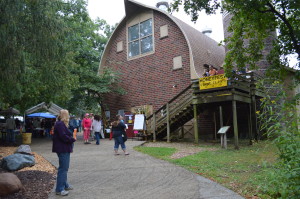
The Indian Creek Nature Center will be relocating from its current office space in this adapted barn, headquarters to the center since its inception in 1973. (photo/Cindy Hadish)
CEDAR RAPIDS – The Indian Creek Nature Center will be moving its offices to a new location, planned for a half-mile away from its current site in southeast Cedar Rapids.
Executive Director John Myers said groundbreaking is expected to take place soon after the fundraising campaign wraps up in 2015, with Cedar Rapids-based Solum Lang Architects selected as lead architect for the project.
“One of our goals with the selection of Solum Lang Architects is to help develop and guide our total building and campus cost so that we can finalize our fundraising campaign goal,” he said. “Once this cost has been completed, we will update the community and our supporters on our progress.”
Myers noted that the Indian Creek Nature Center has a lease on the barn and land surrounding it from the City of Cedar Rapids through 2059.
“We expect to utilize the space for recreational and educational purposes even after we have moved into our new space,” he said. “There is great ecological and educational value on the land the nature center resides on currently and we desire to keep the strong history of the barn as part of the overall mission of the Indian Creek Nature Center as long as feasible.”
Here is more about today’s announcement from the Nature Center:
Today the Nature Center is pleased to announce that Solum Lang Architects has been selected as the lead architect for the new Amazing Space project, a net zero energy design and outdoor learning environment project. The selection of Solum Lang Architects moves Indian Creek Nature Center into a formal design and fundraising campaign scheduled for completion in 2015.
Amazing Space will secure the future of the Indian Creek Nature Center for future generations, encompassing a new building and redesigned campus. The new campus will support an increase in outdoor education programs and the building will be targeted to be a net zero energy use facility. The new building will be located one-half mile down Otis Road from the current barn, on land already owned by Indian Creek Nature Center.
“The future of Indian Creek Nature Center must lie within sustainable, net zero energy design, and a continued commitment to outdoor education. Solum Lang has the innovative skills and passion to join our team and partner with us to achieve these goals for the next 40 years” states Executive Director John Myers. Several unique sustainability features will be incorporated into the new Nature Center, including on-site water and waste treatment, rain water runoff basins, and photovoltaic panels producing electricity on-site.
Lead Architect Brad Lang says, “It is truly an honor and privilege to be selected as design team by such a well-respected organization. We are thrilled and look forward to being a part of the Nature Center’s future plans.”
The selection process was highly competitive and included detailed proposals, in-depth interviews, and reference checks conducted by a volunteer selection committee comprised of seven individuals.
The current building is a 1932 dairy barn, formerly the Pennigroth Dairy, and has been the home of the Nature Center since its inception in 1973. In addition to flooding in 2008, the barn no longer meets the capacity of approximately 40,000 annual visitors. The building also presents challenges such as limited legal access, no air conditioning, critter invasion, and lack of educational and office space.
Located in Cedar Rapids, the Indian Creek Nature Center is Iowa’s first and only privately owned and operated non-profit nature center. With 290 acres of land under its management, the Center hosts a myriad of visitors each year for nature-based activities. The mission of the Indian Creek Nature Center is to promote a sustainable future by nurturing individuals through environmental education, providing leadership in land protection and restoration, and encouraging responsible interactions with nature. It is governed by a volunteer board of directors which sets policy.

No Comments Yet